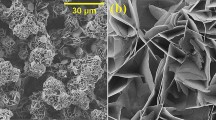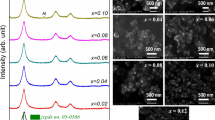Abstract
This work deals with time-resolved accessibility of suitable measurement technique to the solvothermal non-aqueous sol–gel synthesis of aluminum-doped zinc oxide (AZO) nanocrystals via the benzylamine route. Taking into account some limitations, we develop a new concept for using a lab-scale small-angle X-ray scattering (SAXS) camera to obtain detailed information about ongoing particle formation processes during AZO synthesis at the nanoscale range of 10 − 75 nm. Based on this concept, a new growth model is derived providing deep insights regarding process kinetics and morphological changes of AZO during growth. For this purpose, a new method is developed for carrying out and analyzing AZO synthesis in a low process temperature range (≪200 ° C) in order to achieve higher resolution of time-dependent particle formation processes by slowing down process speed. In detail, we show that the consumption of the zinc precursor during synthesis can be recorded by quantitative phase analysis (QPA) and thus validated with gravimetric analysis proving a pseudo-first-order process kinetics for the overall synthesis process. Taking into account the kinetics data, further transmission electron microscopy (TEM) and SAXS analyses are performed to investigate changes in terms of shape, size, and fractal properties leading into the development of a generalized growth model for AZO nanocrystals during synthesis.

.










Similar content being viewed by others
References
Ashcroft NW, Lekner J (1966) Structure and resistivity of liquid metals. Phys Rev 145:83–90
Beaucage G (1995) Approximations leading to a unified exponential/power-law approach to small-angle scattering. J Appl Crystallogr 28:717–728. https://doi.org/10.1107/S0021889895005292
Boukari H, Lin JS, Harris MT (1997) Small-angle X-ray scattering study of the formation of colloidal silica particles from alkoxides: primary particles or not? J Colloid Interface Sci 194:311–318. https://doi.org/10.1006/jcis.1997.5112
Cölfen H, Antonietti M (2005) Mesocrystals: inorganic superstructures made by highly parallel crystallization and controlled alignment. Angew Chem Int Ed 44:5576–5591
Cushing BL, Kolesnichenko VL, O'Connor CJ (2004) Recent advances in the liquid-phase syntheses of inorganic nanoparticles. Chem Rev 104:3893–3946. https://doi.org/10.1021/cr030027b
Dalmaschio CJ, Leite ER (2012) Detachment induced by Rayleigh-instability in metal oxide nanorods: insights from TiO2. Cryst Growth Des 12:3668–3674. https://doi.org/10.1021/cg300473u
Ellinger CR, Nelson SF (2014) Selective area spatial atomic layer deposition of ZnO, Al2O3, and aluminum-doped ZnO using poly (vinyl pyrrolidone). Chem Mater 26:1514–1522
Garnweitner G, Grote C (2009) In situ investigation of molecular kinetics and particle formation of water-dispersible titania nanocrystals. Phys Chem Chem Phys 11:3767–3774
Garnweitner G, Tsedev N, Dierke H, Niederberger M (2008) Benzylamines as versatile agents for the one-pot synthesis and highly ordered stacking of anatase nanoplatelets. Eur J Inorg Chem 2008:890–895
Glatter O, Kratky O (eds) (1982) Small-angle X-ray scattering. Academic Press, New York
Goertz V, Gutsche A, Dingenouts N, Nirschl H (2012) Small-angle X-ray scattering study of the formation of colloidal SiO2 stober multiplets. J Phys Chem C 116:26938–26946
Guo X, Gutsche A, Nirschl H (2013a) SWAXS investigations on diffuse boundary nanostructures of metallic nanoparticles synthesized by electrical discharges. J Nanopart Res 15:2058
Guo X, Gutsche A, Wagner M, Seipenbusch M, Nirschl H (2013b) Simultaneous SWAXS study of metallic and oxide nanostructured particles. J Nanopart Res 15:1559. https://doi.org/10.1007/s11051-013-1559-8
Gutsche A, Daikeler A, Guo X, Dingenouts N, Nirschl H (2014) Time-resolved SAXS characterization of the shell growth of silica-coated magnetite nanocomposites. J Nanopart Res 16:2475. https://doi.org/10.1007/s11051-014-2475-2
Gutsche A, Meier M, Guo X, Ungerer J, Nirschl H (2017) Modification of a SAXS camera to study structures on multiple scales. J Nanopart Res 19:321
Ismail B, Abaab M, Rezig B (2001) Structural and electrical properties of ZnO films prepared by screen printing technique. Thin Solid Films 383:92–94
Jia B, Gao L (2008) Growth of well-defined cubic hematite single crystals: oriented aggregation and Ostwald ripening. Cryst Growth Des 8:1372–1376. https://doi.org/10.1021/cg070300t
Jiang X, Wong FL, Fung MK, Lee ST (2003) Aluminum-doped zinc oxide films as transparent conductive electrode for organic light-emitting devices. Appl Phys Lett 83:1875–1877. https://doi.org/10.1063/1.1605805
Karlak R, Burnett D (1966) Quantitative phase analysis by X-ray diffraction. Anal Chem 38:1741–1745
Kelchtermans A, Elen K, Schellens K, Conings B, Damm H, Boyen HG, D'Haen J, Adriaensens P, Hardy A, van Bael MK (2013) Relation between synthesis conditions, dopant position and charge carriers in aluminium-doped ZnO nanoparticles. RSC Adv 3:15254–15262
Livage J, Henry M, Sanchez C (1988) Sol-gel chemistry of transition metal oxides. Prog Solid State Chem 18:259–341
Ludi B, Süess MJ, Werner IA, Niederberger M (2012) Mechanistic aspects of molecular formation and crystallization of zinc oxide nanoparticles in benzyl alcohol. Nanoscale 4:1982–1995
Luo L, Rossell MD, Xie D, Erni R, Niederberger M (2012) Microwave-assisted nonaqueous sol–gel synthesis: from Al: ZnO nanoparticles to transparent conducting films. ACS Sustain Chem Eng 1:152–160
Minami T (2005) Transparent conducting oxide semiconductors for transparent electrodes. Semicond Sci Technol 20:S35–S44
Nie D, Xue T, Zhang Y, Li X (2008) Synthesis and structure analysis of aluminum doped zinc oxide powders. Sci China Ser B Chem 51:823–828
Niederberger M (2007) Nonaqueous sol–gel routes to metal oxide nanoparticles. Acc Chem Res 40:793–800
Niederberger M, Cölfen H (2006) Oriented attachment and mesocrystals: non-classical crystallization mechanisms based on nanoparticle assembly. Phys Chem Chem Phys 8:3271–3287
Olliges-Stadler I, Rossell MD, Süess MJ, Ludi B, Bunk O, Pedersen JS, Birkedal H, Niederberger M (2013) A comprehensive study of the crystallization mechanism involved in the nonaqueous formation of tungstite. Nanoscale 5:8517–8525
Özgür Ü et al (2005) A comprehensive review of ZnO materials and devices. J Appl Phys 98:11
Patil A, Dighavkar C, Borse R (2011) Al doped ZnO thick films as CO2 gas sensors. J Optoelectron Adv Mater 13:1331–1337
Penn RL, Soltis JA (2014) Characterizing crystal growth by oriented aggregation. CrystEngComm 16:1409–1418
Pinna N, Niederberger M (2008) Surfactant-free nonaqueous synthesis of metal oxide nanostructures. Angew Chem Int Ed 47:5292–5304
Pinna N, Garnweitner G, Antonietti M, Niederberger M (2005) A general nonaqueous route to binary metal oxide nanocrystals involving a C−C bond cleavage. J Am Chem Soc 127:5608–5612
Porod G (1951) Die Röntgenkleinwinkelstreuung von dichtgepackten kolloiden Systemen. Kolloid-Zeitschrift 124:83–114
Schmidt P (1991) Small-angle scattering studies of disordered, porous and fractal systems. J Appl Crystallogr 24:414–435. https://doi.org/10.1107/S0021889891003400
Schnablegger H, Singh Y (2013) The SAXS guide. Anton Paar GmbH
Singh MA, Ghosh SS, Shannon RF Jr (1993) A direct method of beam-height correction in small-angle X-ray scattering. J Appl Crystallogr 26:787–794. https://doi.org/10.1107/S0021889893005527
Song RQ, Cölfen H (2010) Mesocrystals—ordered nanoparticle superstructures. Adv Mater 22:1301–1330
Soofivand F, Tavakoli F, Salavati-Niasari M (2014) Synthesis and characterization of Zn(acac)2 one-dimensional nanostructures by novel method. Sumy State University
Strachowski T, Grzanka E, Lojkowski W, Presz A, Godlewski M, Yatsunenko S, Matysiak H, Piticescu RR, Monty CJ (2007) Morphology and luminescence properties of zinc oxide nanopowders doped with aluminum ions obtained by hydrothermal and vapor condensation methods. J Appl Phys 102:073513
Stubhan T, Oh H, Pinna L, Krantz J, Litzov I, Brabec CJ (2011) Inverted organic solar cells using a solution processed aluminum-doped zinc oxide buffer layer. Org Electron 12:1539–1543
Virtanen A, Ristimäki J, Keskinen J (2004) Method for measuring effective density and fractal dimension of aerosol agglomerates. Aerosol Sci Technol 38:437–446
Wang ZL (2004) Nanostructures of zinc oxide. Mater Today 7:26–33. https://doi.org/10.1016/S1369-7021(04)00286-X
Yoon M, Lee S, Park H, Kim H, Jang M (2002) Solid solubility limits of Ga and Al in ZnO. J Mater Sci Lett 21:1703–1704
Zellmer S, Kockmann A, Dosch I, Temel B, Garnweitner G (2015) Aluminum zinc oxide nanostructures with customized size and shape by non-aqueous synthesis. CrystEngComm 17:6878–6883. https://doi.org/10.1039/c5ce00629e
Zhang Q, Liu S-J, Yu S-H (2009) Recent advances in oriented attachment growth and synthesis of functional materials: concept, evidence, mechanism, and future. J Mater Chem 19:191–207
Acknowledgements
We express our immense thanks to Mr. Tim Köhler and Mr. Florian Kaiser for the experimental assistance and Mrs. Sabrina Zellmer for fruitful discussions.
Funding
The research leading to these results has received funding from the German Research Foundation (DFG Ni 414/24-1 and Ga 1492/9-1).
Author information
Authors and Affiliations
Corresponding author
Ethics declarations
Conflict of interest
The authors declare that they have no conflict of interest.
Additional information
Publisher’s note
Springer Nature remains neutral with regard to jurisdictional claims in published maps and institutional affiliations.
Rights and permissions
About this article
Cite this article
Ungerer, J., Thurm, AK., Meier, M. et al. Development of a growth model for aluminum-doped zinc oxide nanocrystal synthesis via the benzylamine route. J Nanopart Res 21, 106 (2019). https://doi.org/10.1007/s11051-019-4547-9
Received:
Accepted:
Published:
DOI: https://doi.org/10.1007/s11051-019-4547-9




